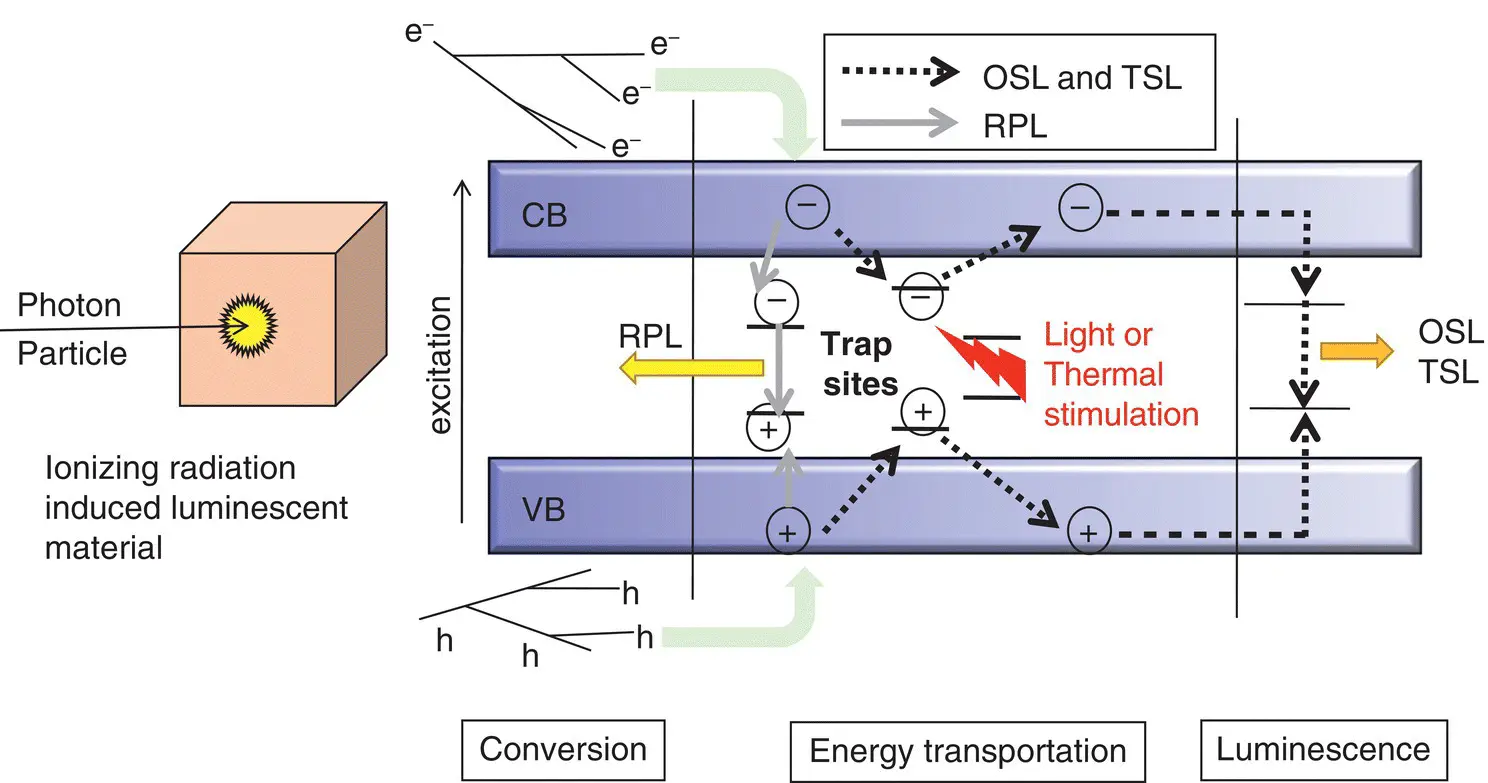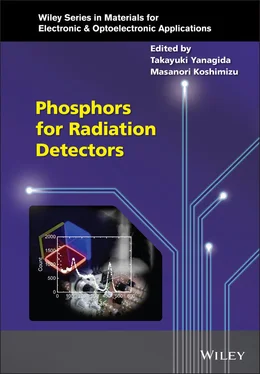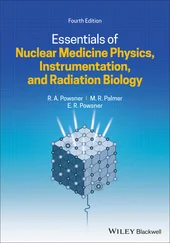The temperature dependence relates to emission mechanisms, described in Section 1.3. Previously, AFL was considered to have no temperature dependence, since it was due to an electron transition between core and valance band, and it was experimentally confirmed from room temperature to ~90 °C [78]. However, recent research reveals that even AFL shows temperature dependence when it is investigated at higher temperatures than 100 °C [26].
1.4 Ionizing Radiation Induced Storage Luminescence
1.4.1 General Description
As explained in Section 1.3, after the absorption of ionizing radiations in a material, a large number of secondary electrons are generated, some of which contribute to scintillation. On the other hand, some of the other secondary electrons are trapped at trap sites which are often caused by lattice defects, and they sometimes become meta‐stable. In this case, if we input the energy corresponding to the energy difference between the bottom of the conduction band and the trap site which is considered as a trap depth, then these trapped electrons can be re‐excited, and some of them can reach luminescence centers to emit photons. We refer to the input of the energy as a stimulation. When the stimulation is an illumination of light or heating, we call the emission phenomena an OSL or TSL, respectively. In the case where the trap depth is deeper than the energy of room temperature, we can store the information of the incident ionizing radiation as a form of the carrier trapping stably for a long time, and we can use such a storage phosphor with a deeper trap for the personal dosimeter. RPL can be considered as one of the special trapping phenomena. In the cases of OSL and TSL, the trapping site occupied with an electron or a hole does not show a PL property. But in a special case, the trapping site occupied by an electron or a hole can obtain a function of PL. In this case, we can observe a PL by such a newly generated emission center consisting of the trapping site and carrier, and we call this PL as RPL. These newly generated emission centers are called RPL centers. Figure 1.8shows a similar drawing, but for TSL, OSL, and RPL, refer to Figure 1.3.

Figure 1.8 Emission mechanisms of TSL, OSL, and RPL.
1.4.2 Analytical Description of TSL
There are several analysis methods of TSL, and here we introduce a model based on reaction kinetics. The following explanations on TSL analysis can be found in previous literature [79, 80]. In this section, we briefly introduce the common understanding of the analytic formula of TSL, while detailed explanations on practical applications appear in Chapter 7. If we assume E as the threshold of thermal ionization, the probability of thermal ionization is a typical Boltzmann distribution such as
(1.27) 
where s , k , and T represent the frequency factor, the Boltzmann constant, and the temperature, respectively. We define n , m , η , and ζ as concentration of free electron, concentration of free hole, proportional constant of radiative recombination, and proportional constant of non‐radiative recombination, respectively. Here, if N is the total number of the electron trapping centers, and n 1is the number of the trapping centers occupied with an electron, then N ‐ n 1is a number of empty trapping centers. If we define α as a retrapping coefficient, the time dependence of n 1is
(1.28) 
We can use the same equation for the trapping center occupied with a hole assuming M as the number of trapping centers for the hole, m 1as the number of trapping centers occupied with the hole, and E ' as an activation energy for the hole to the valence band, and the time dependence of the hole center is
(1.29) 
where s ' is a frequency factor for the hole, γ ' is the retrapping coefficient of the free hole, and γ mis the recombination coefficient, respectively. We assume J is a constant energy absorption of material (constant), and the number of free electrons and free holes are generated proportional to αJ , where α is a proportional constant. Then, the time dependence of concentrations of electrons and holes are
(1.30) 
and
(1.31) 
respectively. In these equations, d n 1/d t and d m 1/d t represent a charging (trapping) process, and ( η + ζ ) nm and Β m nm 1represent dissipation processes. Let us consider the energy dissipation after stopping the irradiation at temperature T . In this case, if we assume J = 0 in (1.27)– (1.30)at time t = 0, then TL from the electron centers by electron release is
(1.32) 
After this time, the time dependence of concentration of electron trapped centers is
(1.33) 
If we assume temperature T 0< < E/k and the heating rate of β , the temperature is
(1.34) 
The simplest model of luminescence process under this condition is the Randall–Wilkins model. In this classical model, retrapping of electrons is not considered ( γ = 0). If we assume ( η + ζ ) = 0 in Equation (1.30), the TSL intensity can be written as
(1.35) 
If we change a variable of Equation (1.33)by Equation (1.34), the temperature dependence of the electron concentration can be expressed as
(1.36) 
and after the integration of Equation (1.35)by temperature T , we can obtain
(1.37) 
Читать дальше
























